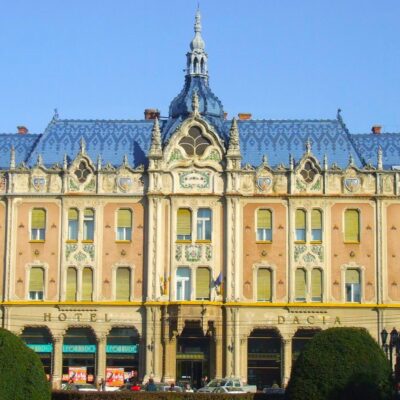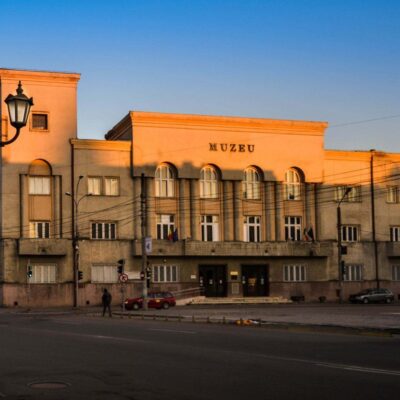Satu Mare is a city with an indisputable historical richness with an impressive number of cultural buildings – museums, memorial houses, monuments, statues, places of worship. In the area, traditions and folk art are preserved with religiosity, which is one of the most representative and appreciated aspects of the area.
The first documentary attestation of the place was made in 1150, under the name of “Zotmar” which later became “Sătmar”. In 1247 it was the residence of the King of Hungary, after which it came under Ottoman occupation and later Habsburg occupation. The period of industrial development and the end of the Second World War led to the modernization and rise of the region.
Satu Mare is the municipality of the homonymous county and is located in the northwest of the country, on the river Someș. The predominant geographical unit of the area is the plain (Western Plain, Câmpia and Lunca Someșului), followed by hills (Western Hills and Crasnei Hills) and mountains (Oaș Mountains and Igniș Mountains). The highest altitude is 1307 m, in the Igniș Mountains. Its neighbours are: to the north – Ukraine, to the east – Maramureș, to the south – Sălaj, and to the west – Hungary.
It was erected in 1904 at the initiative of Bishop Gyula Meszlényi, with a total height of 47 m and a usable height of 34 m. Designed by Ferencz Dittler and built by Lajos Vajnay, the tower offered a panoramic view of the city and was used for surveillance and fire prevention. Today, it is a popular tourist attraction, visited daily by approximately 50 people.
Initially, the tower was installed above a building and served as an observer for public order surveillance and fire detection until 1900, when it was demolished to make way for the “DACIA” hotel and catering complex.
Visiting hours are daily from 4:00 PM to 9:00 PM, except on Mondays.

Initially named Hotel Pannonia, it is an important historical monument located in Satu Mare. Its construction took place between 1901 and 1902, according to the plans elaborated by architects Bálint Zoltán and Jámbor Lajos. With an impressive Secession architectural style, it has a long history; the hotel has been a symbol of the city since its inauguration.
Originally, the hotel was designed to offer high-quality accommodation and hospitality services, being a landmark for tourists and guests of the city. Over time, Hotel Pannonia witnessed significant events in local history.
Today, the hotel is known as Hotel Dacia and continues to be a significant presence in the urban landscape of Satu Mare. With imposing architecture and modernized services, this historical monument attracts both tourists and locals, representing an integral part of Satu Mare’s cultural heritage.

It is the largest cultural institution in the county, comprising 23 museums, memorial houses, peasant households, and archaeological sites. It was founded in 1891 as the Kölcsey Circle, and in 1958, it received the status of County Museum. The administrative headquarters, located at 21 Dr. Vasile Lucaciu Boulevard, houses both permanent and temporary exhibitions. The building, constructed in 1936 as the Prefecture headquarters, became a museum in 1984. The archaeological collection includes objects from various sources, including the collections of the Kölcsey Circle and the Satu Mare County Museum. The museum also has a restoration and conservation laboratory, three libraries, and its own publishing house, and its heritage comprises 400,000 heritage objects.
Over time, it has had various uses: prefecture, headquarters of the County People’s Council, headquarters of the County Committee, and museum. Here, historical, ethnographic, and archaeological collections have been preserved.

It is a significant religious building erected in the 18th century. It is one of the representative monuments for the city of Satu Mare and is included in the official list of historical monuments in Satu Mare County. Its construction represents exceptional historical and architectural value in the urban landscape of the city.

It is an important Jewish place of worship, built between 1889 and 1892 in Moorish style. Alongside the synagogue, the “Saare Tora” Synagogue operates, differing in style, being in the Baroque style.
Currently, the Great Temple is included in the list of historical monuments and hosts various cultural and religious activities for the Jewish community.

Satu Mare does have an airport but it only has domestic flights (Tarom company) to Bucharest and an international one (WizzAir) to London. The nearest airport that has flights to several European countries is Cluj-Napoca, 170 km away. It has both international and domestic flights.
If you want to get from Bucharest to Satu Mare you can choose to travel by train. But the journey will be a long one, so it would be advisable to opt for a place in coach. Trains leave from CFR Satu Mare station to most cities and towns in the country.
If you prefer a faster option, you can choose to travel by bus / minibus. Here you will find all the necessary information for this: bus stations and stops, departure and arrival times, destinations.
If you come from Bucharest by car, the recommended route is: Bucharest – Brașov – Târgu Mureș – Cluj Napoca – Satu Mare or Bucharest – Pitești – Sibiu – Cluj-Napoca – Satu Mare.

If you like music festivals, in Constanta you will find one to your taste, regardless of the style of music you prefer. Here you have a list with some of them, but you should know that every weekend there are events for all tastes.
SamFest Jazz – a music, jazz & blues festival that brings together both national and international artists. It takes place between 21 – 23 June, in Ștefan Ruha Passage, near the Firemen’s Tower.
What are you waiting for? Come and have a good time, enjoy music, nice people and magical places.